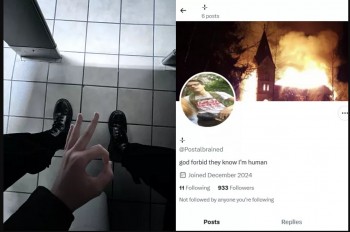Shooter Natalie Rupnow: A Turbulent Childhood, Therapy, and a Tragic End
 |
| Teenage Shooter Natalie "Samantha" Rupnow is also pitiful |
On a cold December morning in Madison, Wisconsin, the serenity of Abundant Life Christian School was shattered. Natalie “Samantha” Rupnow, a 15-year-old female student, unleashed a wave of violence that ended with the tragic loss of three lives, including her own.
Beneath the headlines of horror lies a story of a troubled girl shaped by a fractured family, unresolved trauma, and a desperate cry for help that went unnoticed.
A Family Torn Apart
Natalie’s early life was marked by the instability of her parents’ tumultuous relationship. Born into a family that would eventually dissolve, she spent her formative years navigating the emotional chaos of divorce. The bitter separation of her parents left Natalie without the steady foundation that is vital for a child’s emotional development.
Parental divorce often carries profound psychological consequences for children, with feelings of abandonment, confusion, and guilt surfacing in its wake. Natalie was no exception. Her interactions with her parents became strained, as she tried to find her place between two fragmented households. The environment of conflict and inconsistency deprived her of the security needed to process her emotions in a healthy manner.
Experts suggest that children from divorced families are at a higher risk of experiencing anxiety, depression, and social withdrawal. For Natalie, these effects seemed to compound over time, creating a deep-seated sense of alienation and resentment that would later manifest in catastrophic ways.
 Jeff Rupnow's Facebook Photos: Shooting Practice and Killer Eric Harris Jeff Rupnow's Facebook Photos: Shooting Practice and Killer Eric Harris |
The Role of Therapy
In an effort to address her struggles, Natalie’s parents enrolled her in therapy. Mental health professionals worked to help her process the emotional weight of her family dynamics and build coping mechanisms. However, therapy is not a cure-all. Its success depends on a supportive environment outside the therapy room—something Natalie seemed to lack.
While therapy may have provided her with tools to manage her emotions, the unresolved tension in her home life likely limited its effectiveness. Without reinforcement at home or a consistent structure to implement the lessons from therapy, her progress faltered. The absence of sustained parental involvement left Natalie feeling unsupported, deepening her feelings of hopelessness.
The Descent Into Darkness
As Natalie struggled with her inner turmoil, she turned to the internet, where she found solace in the anonymity it offered. Over time, her online activity began to reflect a disturbing fascination with violence. Reports indicate that she followed content glorifying school shooters and spent hours engaging in discussions about infamous acts of violence, including the Columbine High School massacre.
One haunting photograph of Natalie at a shooting range depicts her wearing a T-shirt emblazoned with the logo of the industrial band KMFDM—a group associated with the Columbine shooters. Friends and classmates noted that she had become increasingly withdrawn, her behavior punctuated by outbursts of anger and troubling comments about societal injustices.
In the weeks leading up to the attack, Natalie reportedly compiled a manifesto that authorities would later find on her laptop. Titled “War Against Humanity,” the document outlined extremist ideologies, targeting men and those she perceived as enablers of patriarchal systems. The manifesto revealed the depth of her rage, describing men as “irredeemable parasites” and advocating for their eradication. The disturbing contents painted a picture of a mind consumed by hatred and despair.
The Tragic Day
On December 16, 2024, Natalie arrived at Abundant Life Christian School armed with a 9mm handgun. Witnesses recalled seeing her enter the study hall with a blank expression, her movements deliberate. In a matter of moments, she opened fire, killing a teacher and a fellow student before turning the weapon on herself.
The school was thrown into chaos as students fled for their lives. First responders arrived within minutes, but the damage had already been done. Natalie was pronounced dead at the hospital, leaving behind a grieving community and a trove of unanswered questions.
The Aftermath and Unanswered Questions
The discovery of Natalie’s manifesto and her online activity shocked the Madison community. How could a 15-year-old girl, known to teachers and peers as shy and academically capable, descend into such violence? Investigators have pointed to the intersection of her turbulent childhood, unresolved trauma, and growing obsession with extremist ideologies as contributing factors.
The role of her family dynamic remains a crucial focal point in understanding her descent. Children like Natalie, who grow up in homes with inconsistent support, often struggle to find healthy outlets for their emotions. While her parents sought help through therapy, the lack of follow-through at home may have left Natalie feeling abandoned—a sentiment that her online communities exploited.
A Call for Change
Natalie’s tragic story underscores the urgent need for comprehensive mental health support for at-risk youth. Therapy must be part of a broader framework that includes active parental involvement, school support systems, and community engagement. Early intervention and consistent follow-up can make a significant difference in helping children navigate their challenges and avoid destructive paths.
Additionally, the accessibility of firearms to minors demands serious scrutiny. Reports indicate that Natalie obtained her weapon from a relative’s unsecured collection, a preventable oversight that cost innocent lives. Stricter gun storage laws and education on firearm safety could prevent such tragedies in the future.
A Community in Mourning
The Madison community continues to grapple with the aftermath of Natalie’s actions. Families mourn the loss of their loved ones, while educators and students try to rebuild their sense of safety. For those who knew Natalie, the tragedy is doubly painful—the realization that a once-promising young girl became the architect of such destruction is hard to reconcile.
Natalie’s story is a sobering reminder of the complexities of mental health, family dynamics, and the influence of online subcultures. It challenges society to do better: to recognize the signs of distress in young people, to provide them with the tools and support they need, and to ensure that no other child follows the same tragic path.
Final Words
Natalie “Samantha” Rupnow’s life was one of unrealized potential, shaped by the scars of a turbulent childhood and unaddressed trauma. While her actions were horrific, they were also a reflection of a system that failed to provide the care and stability she so desperately needed. Her story calls on parents, educators, and communities to look deeper, act sooner, and create a world where children can thrive, no matter their circumstances.
 Natalie Rupnow Pictured Wearing 'KMFDM' Shirt: Tragic Coincidence or Disturbing Copycat? Natalie Rupnow Pictured Wearing 'KMFDM' Shirt: Tragic Coincidence or Disturbing Copycat? The Abundant Life Christian School shooting in Madison, Wisconsin, has triggered unsettling comparisons to past tragedies after 15-year-old shooter Natalie 'Samantha' Rupnow was photographed wearing ... |
 What is a 9mm Pistol That Natalie Rupnow Used for Shooting What is a 9mm Pistol That Natalie Rupnow Used for Shooting View the Weapon Used in the School Shooting in Wisconsin. The 9mm pistol (handgun), its features, and its part in similar tragic incidents will all ... |
 What is Natalie Rupnow share on social media before shooting What is Natalie Rupnow share on social media before shooting Natalie Rupnow's own social media accounts have been deactivated or set to private. |
 What is the Origin of the Handgun Used by Natalie Rupnow? What is the Origin of the Handgun Used by Natalie Rupnow? Tracing the Origin of a Handgun: How Police and ATF Are Investigating the Madison School Shooting |
 True answers in rare case of Natalie Rupnow's shooter: Motive appears to be Combination of Factors? True answers in rare case of Natalie Rupnow's shooter: Motive appears to be Combination of Factors? Abundant Life Christian School shooting latest: Motive appears to be combination of factors, police say |
























